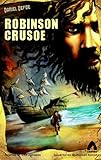 Campfire has sent me a slew of review copies, and I keep being generally impressed. Tonight, I'm going to compare and contrast a book from their Campfire Classic line, Robinson Crusoe (adapted by Dan Johnson, illustrated by Naresh Kumar, colors by Anil C.K.) with a book from their Campfire Mythology line, Ryan Foley's Legend: The Labors of Heracles (illustrated by Sankha Banerjee, colors by Ajo Kurian).
Campfire has sent me a slew of review copies, and I keep being generally impressed. Tonight, I'm going to compare and contrast a book from their Campfire Classic line, Robinson Crusoe (adapted by Dan Johnson, illustrated by Naresh Kumar, colors by Anil C.K.) with a book from their Campfire Mythology line, Ryan Foley's Legend: The Labors of Heracles (illustrated by Sankha Banerjee, colors by Ajo Kurian).It's not an unnatural pairing considering the religious overtones in both. Crusoe is sort of a 18th
 century Jesus, and in the early days of Christianity, it wasn't rare for Greeks and Romans to confuse Jesus with the gods in their pantheon. There's more than a little Christ in Hercules.
century Jesus, and in the early days of Christianity, it wasn't rare for Greeks and Romans to confuse Jesus with the gods in their pantheon. There's more than a little Christ in Hercules.Regarding the Robinson Crusoe adaptation, Christianity rules the day. Those looking for the critique of government and economy will have to squint a bit, but those who like to read the text as a Christian allegory or Christian coming of age story will be most pleased. Indeed, I can see the text having much utility in Christan schools or Sunday school classrooms.
The coloring in both texts continues the Campfire tradition of offering an intriguing palette. At their best, the images seem to be painted and vibrantly give the pages a warm, active glow. This is especially true for the Heracles book. In contrast, the colors in Robinson Crusoe sometimes live up to Campfire's standards but other times look more like an overdone oil pastel, muddy and ragged. To the artists' credit though, a haggard, rough, jagged line is appropriate when illustrating the trials and tribulations of a mere mortal. Heracles, a man-god, is better suited for beauty.
While the adaptation of Robinson Crusoe sheds a lot of nuance from the original text, Ryan Foley more skillfully parses elements of Hercules' mythos. While I wonder about the historical accuracy of having a young Greek boy paired with a female mentor, Foley frames the narrative such as lovely Lady Demiarties tells the story to young Prenditus, who asks questions at times that Lady D simply says must be answered another day.
Foley also does an excellent job of making sure the more... adulterated elements of Hercules' labors are depicted in a family-friendly manner while also inserting a bit of humor into the text. Perhaps its the extra centuries of lore, or the inherent nebulous nature of myths vs a rather finite core from a source text like a novel, but Foley just seems capable of squeezing more out of his text that Johnson does with his.
For example, in a wonderful example of superimposing, an ovoid panel featuring the face of Eurystheus is placed in a horizontal, rectangular panel in which Heracles shovels poop from his stables. The oval fits neatly "in" the pile of poop, a perfect place for the shithead king.
Then there's the undeniable bit of tastiness that is Heracles petting Cerberus: "Who's a good dog? Huh? Who's a good dog? You are. Cerberus is a good dog."
Both books offer extra information at the end. Johnson offers history of other famous shipwrecks rather than explore the nixed sub-themes of Defoe's masterpiece, and Foley offers the history of several other key Greco-Roman deities to help readers keep the hulking half-god heroes of antiquity distinct.
I enjoyed reading both. I love Daniel Defoe's Robinson Crusoe, so much that I actually explored the theme of middle spaces in my application for doctoral programs, but not necessarily for the same reasons that Johnson's adaptation will bring to the fore. Still, it's an impressive book that will absolutely serve its best purpose as a text exploring Christian themes. Folley's Legend: The Labors of Heracles is an absolute blast, however, a ten out of ten to Robinson Crusoe's worthy 8.
Again, to sum it: It's not that Campfire's Robinson Crusoe isn't strong, it's just not as strong as Hercules.

No comments:
Post a Comment